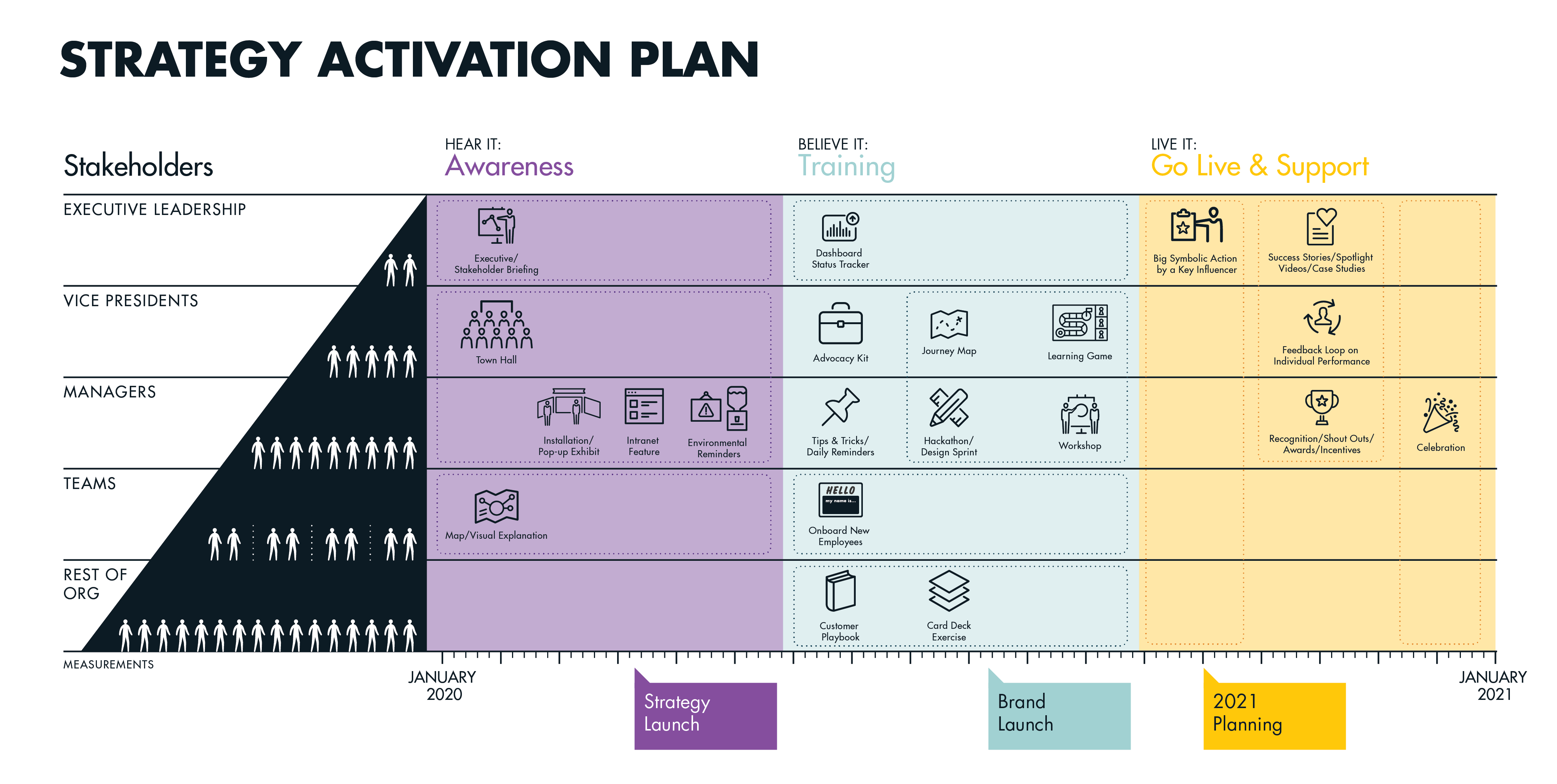A UX Designer’s Blueprint for Organizational Change
In an era of rapid digital transformation, 70% of strategic initiatives fail due to poor execution, not vision (Harvard Business Review, 2022). As a Senior UX Designer with many years of experience, I’ve learned that aligning strategy with human behavior is the linchpin of success. This guide dives into designing a Strategy Execution Plan—a systematic, empathy-driven approach to turning abstract goals into an actionable reality.
Why Strategy Execution Requires a Human-Centered Approach
Strategy execution isn’t just about Gantt charts and KPIs; it’s about understanding how people think, feel, and adapt. Traditional methods often overlook the “activation curve”—a concept borrowed from innovation adoption theory (Rogers’ Diffusion of Innovations), which segments stakeholders based on their readiness to change. Your goal? Move stakeholders from passive observers to active champions.
Components of an Activation Plan
- Stakeholders: Identify groups across the activation curve (e.g., skeptics, early adopters).
- Milestones: Align with organizational rhythms (e.g., quarterly reviews, product launches).
- Building Blocks: Targeted interventions, such as workshops or feedback loops, tailored to stakeholder needs.
Tools for Crafting Your Plan
1. Empathy: The Foundation of Change
Empathy maps and user personas aren’t just for UX—use them to decode stakeholder fears and motivations. For example, Airbnb’s “Elephant Storytelling” technique fosters empathy by encouraging employees to share vulnerabilities (Harvard Business Review, 2020).
2. Research: Mapping Organizational DNA
- Structural Analysis: Use tools like SWOT or PESTLE to audit communication channels, office layouts, and remote workflows.
- Channel Audits: Platforms like Slack or Microsoft Teams dominate formal/informal communication. Tools like Miro can visualize these flows.
3. Deep Anthropology: Uncovering Hidden Barriers
Ethnographic methods, like shadowing employees or conducting diary studies, reveal cultural roadblocks. IDEO’s Human-Centered Design Kit offers practical frameworks here.
The Six Phases of Strategy Execution Design
Phase 1: Understand Stakeholders
- Step 1: Segment Groups: Use Mendelow’s Power-Interest Grid to prioritize stakeholders.
- Step 2: Who/Do Exercise: Define what each group must understand and do. For example, leaders need ROI clarity, while staff seek “What’s in it for me?” (ADKAR Model).
- Step 3: Anticipate Obstacles: Address leaders’ resource concerns with data (e.g., McKinsey’s ROI calculators).
Case Study: When Adobe shifted to a subscription model, they used stakeholder-specific messaging to ease fears (Forbes, 2017).
Phase 2: Map Organizational Communication
- Formal Channels: Town halls, intranets (e.g., SharePoint).
- Informal Channels: Slack communities, peer mentoring.
- Environmental Cues: Office signage, branded swag (e.g., Zappos’ culture books).
Tool: Conduct a “Communication Ecosystem Audit” using Trello to categorize channels.
Phase 3: Address Barriers
- Card Sorts: Use Optimal Workshop to identify cultural pain points. For example, “resistance to remote work” might emerge as a theme.
- Barrier Cards: Categorize obstacles (e.g., “solution alignment”) and pair with fixes like co-creation workshops.
Pro Tip: Google’s “Project Aristotle” found psychological safety critical for team success—address this in your plan (re:Work).
Phase 4: Leverage Fixed Milestones
Align your plan with existing events (e.g., annual conferences) to piggyback on organizational momentum. For example, Salesforce uses Dreamforce to unveil strategic shifts.
Tool: Sync milestones with Agile sprints using Jira or Asana.
Phase 5: Build the Plan
- Boundaries: Define timelines using Gantt charts.
- Building Blocks:
- Co-Creation: Involve employees in strategy workshops (Stanford d.school’s Design Thinking Guide).
- Personalization: Use tools like Loom for personalized video updates from leadership.
Example: IBM’s “Design Thinking Jam” sessions engage global teams in strategy refinement (IBM Case Study).
Phase 6: Refine Iteratively
Adopt the Plan-Do-Check-Act (PDCA) cycle. Tools like Hotjar or Qualtrics can track sentiment shifts post-launch.
Bringing It All Together
A well-designed Strategy Execution Plan is a living document. Revisit it quarterly, using tools like Tableau for real-time analytics. Remember, empathy isn’t a phase—it’s a mindset.
Conclusion
Designing a Strategy Execution Plan is less about checklists and more about understanding the human ecosystem. By marrying UX principles with organizational psychology, you turn resistance into momentum.
References
- Harvard Business Review: Why Strategy Execution Unravels (https://hbr.org)
- Rogers’ Diffusion of Innovations (https://www.amazon.com/Diffusion-Innovations-5th-Everett-Rogers/dp/0743222091)
- IDEO Human-Centered Design Kit (https://www.ideo.com/post/design-kit)
- ADKAR Model (https://www.prosci.com/adkar-model)
- Salesforce Dreamforce Case Study (https://www.salesforce.com/dreamforce/)
- Stanford d.school Design Thinking (https://dschool.stanford.edu/resources)


